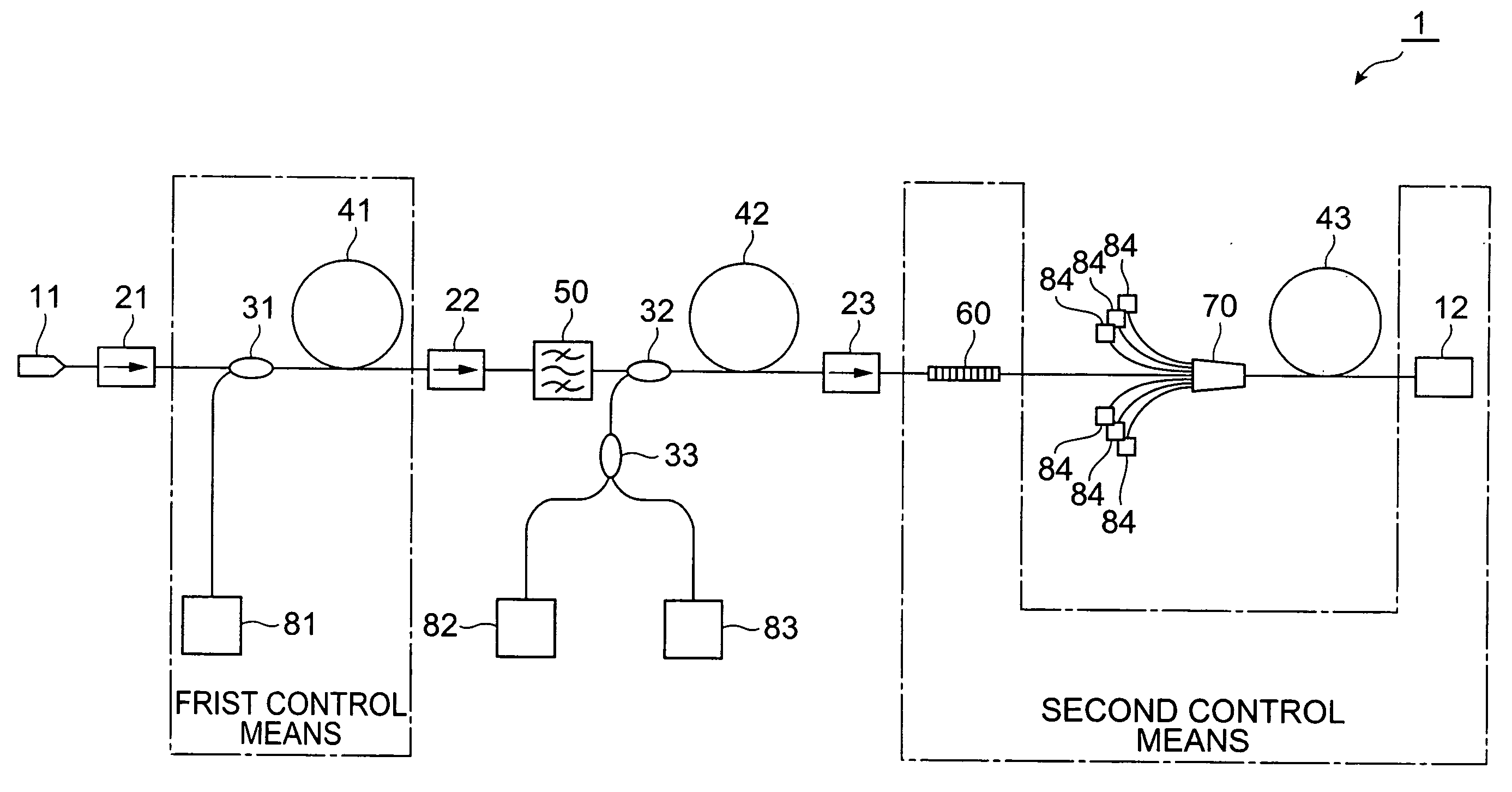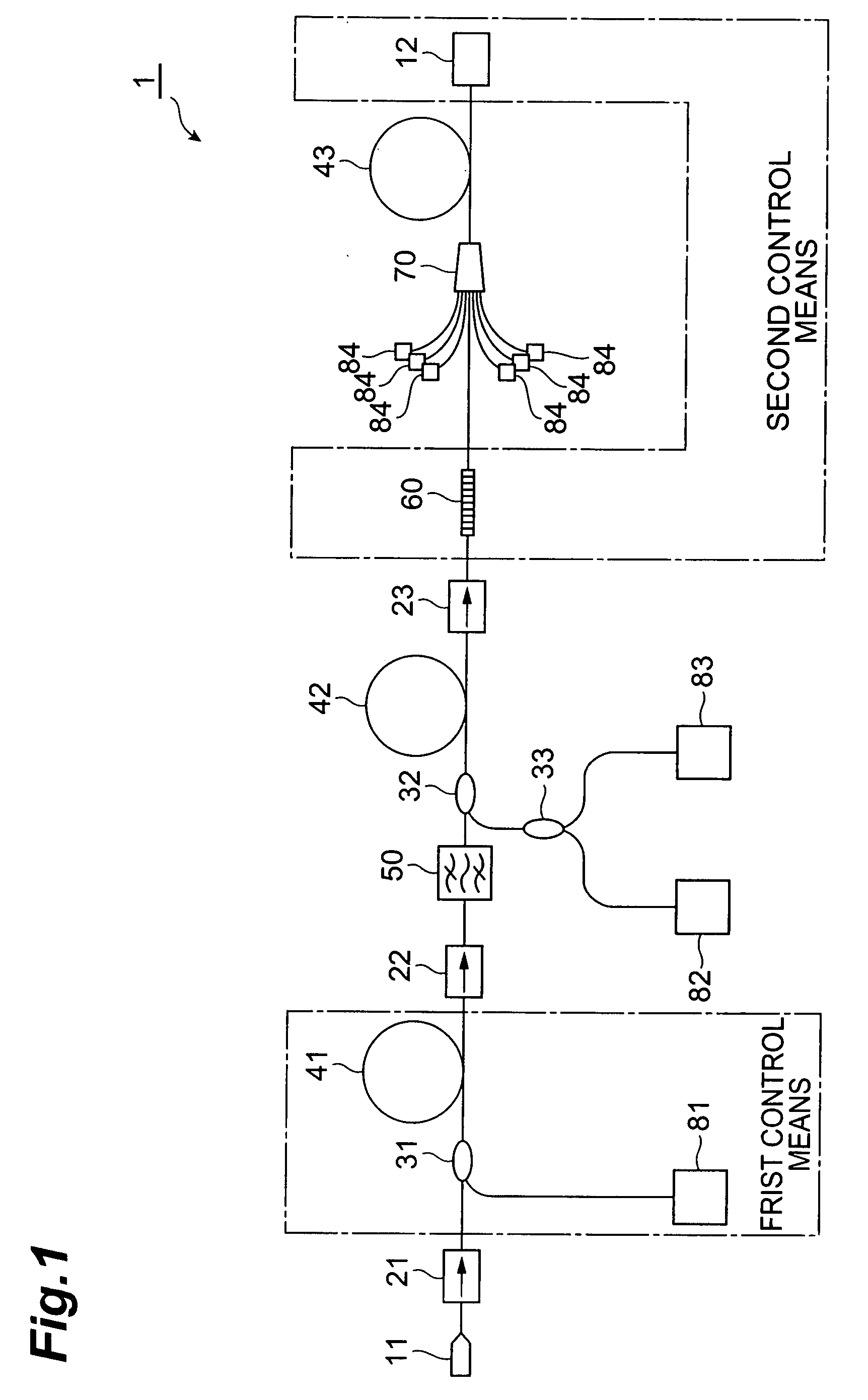Optical fiber amplifying module
- Summary
- Abstract
- Description
- Claims
- Application Information
AI Technical Summary
Benefits of technology
Problems solved by technology
Method used
Image
Examples
first embodiment
[0032]FIG. 1 is a diagram showing the structure of a first embodiment of the optical fiber amplifying module according to the present invention. The optical fiber amplifying module 1 according to the first embodiment shown in FIG. 1 inputs light fed to an input connector 11 and outputs thus amplified light as collimated light from an output collimator 12. The optical fiber amplifying module 1 comprises an optical isolator 21, an optical coupler 31, a YbDF 41, an optical isolator 22, a bandpass filter 50, an optical coupler 32, a YbDF 42, an optical isolator 23, an optical fiber Bragg grating 60, a combiner 70, and a YbDF 43 which are successively arranged from the input connector 11 to the output collimator 12. The optical fiber amplifying module 1 further comprises a pumping light source 81 connected to the optical coupler 31, a polarization beam combiner 33 connected to the optical coupler 32, pumping light sources 82, 83, and a plurality of pumping light sources 84 connected to t...
second embodiment
[0059]FIG. 11 is a diagram showing the structure of a main part in a second embodiment of the optical fiber amplifying module according to the present invention. The basic structure of the optical fiber amplifying module 2 according to the second embodiment is the same as that of the above-mentioned optical fiber amplifying module 1 according to the first embodiment. However, the second embodiment differs from the first embodiment in that it further comprises a first control means feedback structure. FIG. 11 does not depict the structure on the downstream side of the bandpass filter 50, since it is the same as that in the optical fiber amplifying module 1 according to the first embodiment.
[0060]As mentioned above, it is desirable that the gain from the input connector 11 to the optical isolator 22 be not higher than about 15 dB. However, the input and output of light to be amplified having a low duty cycle are hard to monitor accurately. Therefore, the optical fiber amplifying modul...
third embodiment
[0063]FIG. 12 is a diagram showing the structure of a main part in a third embodiment of the optical fiber amplifying module according to the present invention. The basic structure of the optical fiber amplifying module 3 according to the third embodiment is also the same as that of the above-mentioned optical fiber amplifying module 1 according to the first embodiment. However, the first control means in the third embodiment differs from that in the above-mentioned first and second embodiments in that it comprises a structure which makes it possible to protect the pumping light source 81 without monitoring the signal light (light to be amplified) having a low duty cycle. As with FIG. 11, FIG. 12 does not depict the structure on the downstream side of the bandpass filter 50, which is the same as that in the optical fiber amplifying module 1 according to the first embodiment.
[0064]In the optical fiber amplifying module 2 according to the third embodiment, as shown in FIG. 12, the fir...
PUM
 Login to view more
Login to view more Abstract
Description
Claims
Application Information
 Login to view more
Login to view more - R&D Engineer
- R&D Manager
- IP Professional
- Industry Leading Data Capabilities
- Powerful AI technology
- Patent DNA Extraction
Browse by: Latest US Patents, China's latest patents, Technical Efficacy Thesaurus, Application Domain, Technology Topic.
© 2024 PatSnap. All rights reserved.Legal|Privacy policy|Modern Slavery Act Transparency Statement|Sitemap



